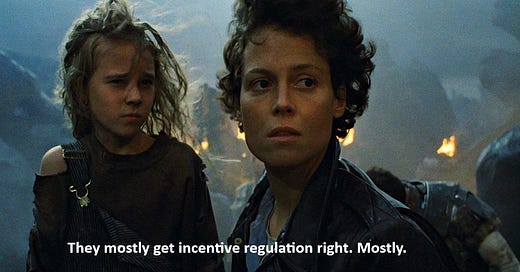Are you immediately suspicious of anything offering “guaranteed returns”? It might just be my demographics, but I can’t watch a Youtube video without being inundated with pyramid schemes, crypto scams and other promises of financial independence if I just sign up to a “Hustler” training course. Sensibly, most of us know that “guaranteed returns” are often anything but. However, you mightn’t know that there’s a type of business in Australia that does effectively get guaranteed returns — and all of us are paying them through our electricity bills.
A lot of things have to happen for you to get an electricity bill. The power needs to be generated, travel through a long series of wires, go through your electricity meter and finally power your home. Then, a whole series of complex interactions and data exchanges happen to get the readings from those meters to your retailer who then sends you your bill.
If you look at your bill, you’ll see a large chunk of those costs are allocated to network costs. A lot of what we pay for is the cost of transporting electricity around the grid, not just the costs of the various generators.
As we ramp up into a global energy transition, a number of truths are becoming apparent. We’re going to need more grid to connect the new renewable generators. We’ll need to pay for this new grid. Lastly, we won’t have the benefit of time — obsessing over trying to design the perfect grid will be too slow and too costly.
So let’s have a look at networks — pesky monopolies and one of the most important components of the energy transition.
Network and monopolies
Network businesses (also known as “network service providers”)1 are dedicated businesses who own, operate and maintain the poles and wires throughout the National Electricity Market (NEM). The high voltage towers are owned by transmission businesses, the arteries of the grid, facilitating the large flows of power across the country. The low voltage distribution networks are the capillaries, connecting up the homes and businesses across the country to the shared grid.
Unlike the generation of electricity or choosing an electricity retailer, networks are natural monopolies. Intuitively, it’s sensible to have a single set of poles and wires instead of having competing businesses setting up duplicate networks. However, the result is a monopoly (a single, exclusive seller), and the problems with monopolies are well understood — there is no competitive pressure on network businesses to deliver an efficient price or high quality service. To address this, network businesses in the NEM are regulated monopolies. This applies to the distribution and transmission networks.2
As regulated monopolies, they aren’t able to set their own prices, because they would be able to charge exorbitant prices. As a regulated monopoly, caps are set on how much revenue they can recover. Setting these costs is tedious, arcane and super important.
How do networks make their “guaranteed returns”?
Networks are regulated to manage their market power. The process of regulating networks has two main arms:
Obligations, imposed on them through regulation. Networks are obligated to do certain things, like setting up new connections (for a price).
Incentives, where financial motives are structured to encourage networks to replicate what an efficient business might do — offer fair prices and provide a good service.
To determine how much money they can make, networks go through an intensive five-year revenue determination process. Networks apply to the Australian Energy Regulator (AER), with a request to recover an amount of money over the five years. After some back and forth with the AER, a final amount is determined and network businesses set their pricing to recover this amount.
There are a range of cost categories in a revenue determination.3 The costs cover five main buckets:
A return on capital, which reflects the costs of financing the network and providing investors with a profit.
Operating costs, such as staff and performing maintenance on lines.
Depreciation, representing the costs of falling asset values as the poles and wires get old, and replacement.
Taxation costs
Any adjustments made under incentive schemes, meant to help encourage networks to innovate.
After the AER agrees a final amount of money, networks set their tariffs for the following five years to allow them to recover these costs.
The costs set by the AER are the “efficient costs” of running the network for five years, not the actual costs. If networks beat this benchmark, they get to pocket the difference. This creates the incentive for networks to outperform the AER’s estimate of what’s efficient. It also highlights the importance of the AER’s job in setting the benchmark - if it’s too high, the network gets free money, if it’s too low, the network would be unprofitable.
Does incentive-based regulation work?
Incentive-based regulation is meant to be a substitute for the competitive pressures networks don’t have to face. Incentive-based regulation isn’t perfect, but the generally accepted view is that it’s still better than the costs of having multiple networks duking it out over a single patch.
There are some challenges thrown up by incentive regulation. One is that networks are incentivised to prefer capital costs (building stuff) over operating costs (staffing, payments to consumers to provide demand management). Capital costs go into the regulatory asset base (RAB), and the network owner will be guaranteed healthy returns over the typically long lifetime of network infrastructure.
It also creates relatively weak incentives to innovate. Networks are tested against benchmarks, and given innovation bonuses (which kinda says it all), but all in all are still monopolies. You have to deal with your local monopoly and their market power.
Complicating everything are the opportunities for networks to earn unregulated revenue. Network businesses are not meant to participate in competitive markets (cause, you know, monopolies and such), but they can provide services outside their regulated services for money. Kind of like a cash in hand gig that the ATO has no oversight over. The AER has also been increasingly open to giving networks businesses waivers, letting them wade into competitive markets to build community batteries etc. This blurs the line between a regulated monopoly, and a business with monopoly-like advantages, which is not great for a normal competitive market.
Anyway, if the AER gets its incentive regulations right, we will get an efficiently built and operated grid, the grid owners will get comfortable returns and energy consumers will get decent services at prices they’re happy to pay for.
If the AER gets it wrong, it’s a bad time to be an energy consumer.
Gold plating
The first big concern is gold plating — referring to the network getting away with an excessive amount of investment in the network. Unlike normal businesses, networks won’t realise a loss for overinvestment. Instead, these costs are bundled into the regulatory asset base, providing guaranteed returns for decades.
Gold plating was in the spotlight around 2008 - 2012, when, following some outages in metropolitan Sydney, the state government set very high reliability standards for the distribution network. In order to meet these standard, the networks in NSW built out massive new network investments, inflating the bills of NSW consumers far beyond the impacts of the carbon tax.
This was not strictly the fault of the networks. They were meeting the standards imposed on them. But this doesn’t alleviate the concerns of gold plating. The hangover of the costs of gold plating, which saw residential bills in NSW surge, echo through to present day conversations about transforming the grid for a renewable future.
Excessive profits
The other concern is how much profit networks are allowed to recover. If the AER sets an excessive benchmark, it would allow networks to make excessive returns on their capital, at the expense of energy consumers.
This was exactly the concern raised in a report Simon Orme of the Institute of Energy Economics and Financial Analysis (IEEFA) at the end of 2022.4 In his report, Orme argued networks were able to recover in excess of $10B above normal profit levels between 2014 and 2021. The source of these costs was attributed mostly to assumptions the regulator made about how and where to set the benchmark for an acceptable level of profit for the network owners.
Of course, this was disputed by the network businesses. Energy Networks Australia argued the claims in the report were not supported by evidence.
Separately to the IEEFA report, the AER’s consumer reference group raised concerns about the financing assumptions the AER was making in setting its rate of return. The consumer reference group also argued that the networks could achieve financing at lower costs than the AER benchmark. If the AER agreed (they didn't), this would translate into lower bills for consumers.
Squaring this with the need to build new transmission
We need to square the concerns about accurate, efficient regulation of monopoly networks with the impending freight train called climate change.
We’re currently at ~ 30% renewables in Australia. We need to get as close to 100% as soon as possible to have the best chance of decarbonising power, heating, transport, industry etc. To do so, we’ll need new transmission lines connecting up areas of wind and sunshine to the grid. This is going to be necessary, but likely not cheap.
On our bills, about 40-50% of the costs go to networks. Most of that is for distribution, so a huge build out of transmission is actually less consequential to the end consumer than over investments in distribution. Still, consumers pay for everything, and in an environment of rising costs of living, the prospects of paying for an overhaul of the transmission network is daunting.
The risk is that consumers foot the bill if we’re too slow as well. If we don’t build transmission fast enough, it will delay the renewables investment, prolonging our reliance on increasingly expensive coal and gas.
We will need to rapidly get on with the process of building new lines to expand our renewable energy capacity — without the ability to have a very high level of checks and balances we would want if we had more time available. This is unfortunate for energy users, and a lot of the blame lies with Australia’s failure to have clear, consistent climate and energy policy for the past 20 years.
So, despite their concerns about being able to raise the funds, potential exposure to some forms of competition, and supply chain challenges, network businesses are in the box seat for the energy transition, overseeing massive investments into the power grid. Those guaranteed returns look guaranteed for the foreseeable future — oh to be a monopoly.
Things happen
Liddell Power Station, Australia’s oldest power station, continues its progressive closure. It will be put out to pasture on Friday, 28 April 2023.
Speaking of AGL, Currently Speaking’s first homegrown conspiracy theory! In the 2008 song Cyanide, Metallica frontman James Hetfield appears to yell “ANDYYYY VESEYYY, Won’t you let me stayyyy?” - Did former AGL CEO Andy Vesey plant these lyrics in anticipation of being pushed out of AGL?? Granted, this song came out seven years before Andy started at AGL…
An op-ed in the AFR from Matthew Warren argues for Australia to consider embracing nuclear energy for the energy transition. The article tries to tackle Australia’s deeply ingrained aversion to nuclear power. It doesn’t focus on the cost and timeline issues that have plagued nuclear power worldwide.
For everyone’s sanity, I’ll just use network business.
The challenges with regulating networks is separate to the challenges with privatisation. There are network businesses owned by governments, and others owned privately. However, for some, the concern about monopolies making more money than they should will be partially ameliorated if that money is going back to public coffers.
For an example, in the five year window from 2019-24, the AER approved Ausgrid recovering $7.7 billion over the five year window. Ausgrid is the distribution network in Sydney, the Central Coast and Hunter Valley.






